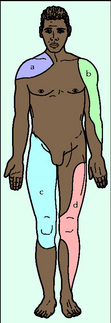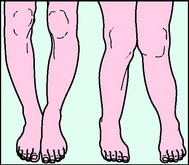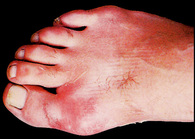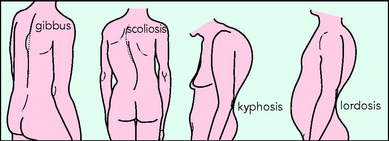Chapter 10 Bone, joint and muscle
SYMPTOMS OF BONE, JOINT AND MUSCLE DISORDERS
Joint
PAIN
• Osteoarthritis and rheumatoid arthritis typically result in chronic pain with periodic exacerbations.
• Inflammatory joint disease tends to cause pain on waking, improving with activity but returning at rest.

Fig. 10.1 Distribution of pain arising from (a) the acromioclavicular or sternoclavicular joints, (b) the scapulohumeral joint, (c) the hip joint and (d) the knee joint.
GENERAL PRINCIPLES OF EXAMINATION
Joint
INSPECTION
Deformity
• Results either from misalignment of the bones forming the joint or from alteration of the relationship between the articular surfaces.
Skin changes
Redness of the skin over a joint implies an underlying acute inflammatory process (e.g. gout or septic arthritis) (Fig. 10.3).
MOVEMENT
• If extension does not normally occur at a joint (e.g. the knee) but is present, describe the movement as hyperextension and give its range in degrees.
• Restricted movement, say of knee extension, is recorded as X° flexion deformity or as X° lack of extension.
Muscle
Initial assessment will include inspection, palpation then testing of muscle power.
INSPECTION
Look for evidence of muscle wasting, signs of abnormal muscle bulk and for spontaneous contractions.
REGIONAL EXAMINATION
Spine
THORACIC SPINE
• Then, with the patient’s arms folded across the chest, ask the patient, while sitting, to twist as far as possible to one side then the other.

 Differential diagnosis: Bone pain
Differential diagnosis: Bone pain Differential diagnosis: Causes of joint pain
Differential diagnosis: Causes of joint pain Differential diagnosis: Causes of muscle pain
Differential diagnosis: Causes of muscle pain

 Symptoms and signs: MRC classification of muscle power
Symptoms and signs: MRC classification of muscle power Symptoms and signs: Spinal deformities (
Symptoms and signs: Spinal deformities (
 Differential diagnosis: Back pain
Differential diagnosis: Back pain

